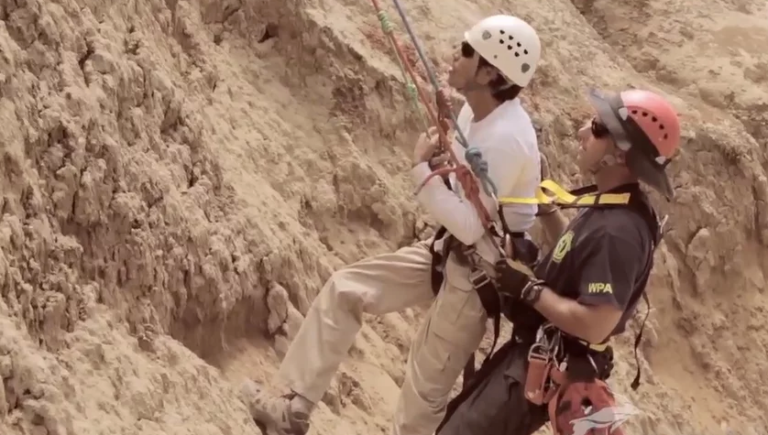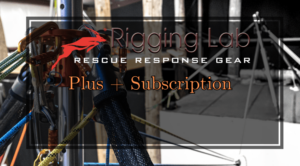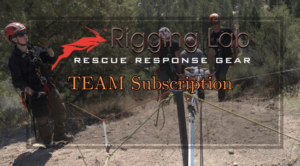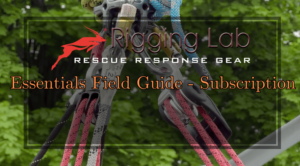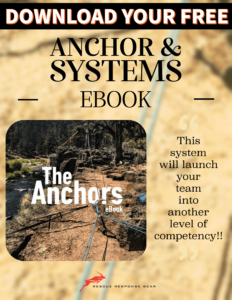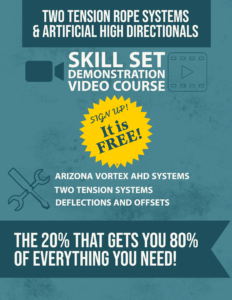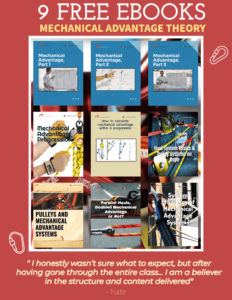For a Team Based pickoff, the MA is rigged at the top by the team, a ganged-on system is usually needed in order to raise the load. Once the victim has been freed, the team based MA lowers the victim onto the pickoff strap.
For a Solo Rescue pickoff, this MA must be rigged by the rescuer. There are a number of ways to do this, and utilizing a pulley system not only to un-weight the victim from his/her’s system but also allow it to double as the primary attachment to the victim. Using an AZTEK or a simple 2:1 mechanical advantage with the moving pulley at the victim will work.
When possible, performing a rescue from above, by lowering down to the subject, is generally preferred due to safety and security.
For a rescue from above, it may be possible for the rescuer to descend (and ascend) a fixed rope under their own power. This may be an attractive option for a number of reasons. Many argue that is dangerous very logical and illogical reasons. Be that as it may, this call is solely up to the AHJ. Teams are made of many individuals and some of these members are highly skilled at their craft. We’ll talk about “suspension rescue” in another section, but suffice it to say it is the bread and butter of rope access rescue skill set. Mountain rescue and many SAR teams don’t have the luxury of large rigging platforms, time or many power. Things can change in an instant.
The Pickoff Rescue
The term pickoff generally refers to the action of a single rescuer accessing a subject in the high angle environment and removing them from the unstable environment they are in and locate them to one of stability and safety. The process normally includes a team, but not always.
There are a few different ways to perform a pickoff rescue. The rescuer can be raised and lowered by other rescuers, or they may be on their own (solo). There are advantages and disadvantages to each.
If the rescuer is raised and lowered by others, it requires good communication and coordination between the rescuers. There is also the potential for the rescuer to swing if not lowered correctly. However, this method allows for a more controlled descent and ascent, and multiple rescuers can assist if needed.
If the rescuer is solo, they will need to be very proficient in pickoff rescue techniques. They will also need to be comfortable with heights. This method is more strenuous and can be more dangerous, but it allows for a faster rescue. Note… regarding the “fear of heights” – many technicians don’t like to admit this, but often, rescuers do not like hanging out in space much less descending on their own in a vertical environment.
Advantages and Disadvantages of rappel and lowering pickoffs
| Advantages | Disadvantages | |
| Pickoff by Descent | Usually requires fewer rescuers Less need for communication |
Not easy to correct mistakes Greater pressure on one rescuer |
| Pickoff by Lower | Rescuer hands remain free Extra rescuers mean greater options |
Requires additional personnel/gear |
While the options are not per say “endless”, there are many ways to perform pickoff maneuvers, so we’ll make some quick tailgate suggestions here.
Pickoff rescue techniques could be appropriate in the following-
- It IS appropriate for a one person to perform the rescue
- A problematic shortage of resources (personnel, time, equipment)
- The benefits outweigh the risks
Some examples of when a pickoff may be required-
- Firefighter egress is blocked for any reason
- Equipment malfunction
- Ill-Equipped worker in suspension
- A climber is incapacitated enough to require a rescue
- A person is in a dangerous environment and fear has taken over
Pickoff rescues bring to the table… everything! Not just systemology, but communication and concentration. The wildcard is fear of heights. We brought this up before, but never underestimate the power of the mind.
When the subject becomes a patient due to injury or something else that increases the level of emergency for any reasons, medical considerations will change “what should be” to “what is” instantaneously. We won’t get into the specifics of badly broken bones, severe bleeding, head trauma and many other injurious aspects of rescue, except to say “a sound mind” and focus of the “here and now” is priority one.
It goes without saying, or at least it should… Always pay attention to –
- Teamwork and Communication
- radio
- voice
- signals
- whistles
- Protecting the Rescuer
- PPE
Peace on your Days
Lance

